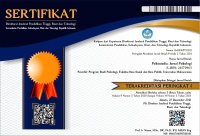Consumer-Brand Identification and Brand Loyalty: Analysis on Customer Satisfaction and Brand Trust as Mediators
Abstract
Keywords
Full Text:
PDFReferences
Al-Eisa, A., & Alhemoud, A. M. (2009). Using a multiple-attribute approach for measuring customer satisfaction with retail banking services in Kuwait. International Journal of Bank Marketing, 27(4), 291–314. https://doi.org/10.1108/02652320910968368
Anderson, R. E., & Srinivasan, S. S. (2003). E-Satisfaction and E-Loyalty : A Contingency Framework. 20(2), 123–138. https://doi.org/10.1002/mar.10063
Bohang, F. K. (2018). Membandingkan Kesetiaan Pengguna Android dan iOS. Kompas.Com. https://tekno.kompas.com/read/2018/03/11/11370017/membandingkan-kesetiaan-pengguna-android-dan-ios
Budiman, A., Yulianto, E., & Saifi, M. (2020). Pengaruh E-Service Quality Terhadap E-Satisfaction Dan E- Loyalty Nasabah Pengguna Mandiri Online. Profit, 14(01), 1–11. https://doi.org/10.21776/ub.profit.2020.014.01.1
Chaudhuri, A., & Holbrook, M. B. (2001). The chain of effects from brand trust and brand affect to brand performance: The role of brand loyalty. Journal of Marketing, 65(2), 81–93. https://doi.org/10.1509/jmkg.65.2.81.18255
Chen, Y.-S., Chen, T.-J., & Lin, C.-C. (2016). The Analyses of Purchasing Decisions and Brand Loyalty for Smartphone Consumers. Open Journal of Social Science, 4, 108–116.
Graciola, A. P., Toni, D. De, Lima, V. Z. De, & Milan, G. S. (2018). Does price sensitivity and price level influence store price image and repurchase intention in retail markets ? 44, 201–213.
Halim, R. E. (2006). The Effect of the Relationship of Brand Trust and Brand Affect on Brand Performance: An Analysis from Brand Loyalty Perspective (A Case of Instant Coffee Product in Indonesia). SSRN Electronic Journal, 1–14. https://doi.org/10.2139/ssrn.925169
Hami, A. El, & Sidik, A. A. (2017). Studi Komparasi Self-Esteem Pengguna Iphone dan Bukan Pengguna Iphone pada Remaja. Psympathic: Jurnal Ilmiah Psikologi, 4(2), 183–192. https://doi.org/10.15575/psy.v4i2.1347
Haumann, T., Quaiser, B., Wieseke, J., & Rese, M. (2014). Footprints in the sands of time: A comparative analysis of the effectiveness of customer satisfaction and customer-company identification over time. Journal of Marketing, 78(6), 78–102. https://doi.org/10.1509/jm.13.0509
He, H., Li, Y., & Harris, L. (2012). Social identity perspective on brand loyalty. Journal of Business Research, 65(5), 648–657. https://doi.org/10.1016/j.jbusres.2011.03.007
Herdyanto, A. (2019). 10 Negara Ini Punya Jumlah Pengguna Smartphone Terbanyak di Dunia! IDN Times. https://www.idntimes.com/tech/gadget/abraham-herdyanto/negara-dengan-jumlah-pengguna-smartphone-terbesar/full
Homburg, C., Wieseke, J., & Hoyer, W. D. (2009). Social Identity and the Service – Profit Chain. 73, 38–54.
Kim, J., Lee, H., & Lee, J. (2020). Smartphone preferences and brand loyalty : A discrete choice model reflecting the reference point and peer effect. Journal of Retailing and Consumer Services, 52. https://doi.org/10.1016/j.jretconser.2019.101907
Kuleh, Y., & Setyadi, D. (2016). The Effect of Brand Trust and Affection on the Attitudinal and Purchase Loyalty of Celluler Telecomunication Customers in East Kalimantan-Indonesia. European Journal of Business and Management Www.Iiste.Org ISSN, 8(24), 86–95. www.iiste.org
Lee, W.-K. (2014). A Framework for Purchase Intentions Toward a Brand-New Smartphone Based on Self-Presentation and Aesthetics *. 24(4), 515–529.
Li, H., Tevrizci, C., & Aham-Anyanwu, N. (2014). An empirical study of e-loyalty development process from the e-service quality experience: Testing the etailq scale. Proceedings - Pacific Asia Conference on Information Systems, PACIS 2014.
Lin, J., Lobo, A., & Leckie, C. (2017). The role of benefits and transparency in shaping consumers’ green perceived value, self-brand connection and brand loyalty. Journal of Retailing and Consumer Services, 35, 133–141. https://doi.org/10.1016/j.jretconser.2016.12.011
Mario, A. D. (2018). iPhone Diklaim Jadi Smartphone Identik Orang Kaya. Liputan 6.Com. https://www.liputan6.com/tekno/read/3583677/iphone-diklaim-jadi-smartphone-identik-orang-kaya
Neuman, W. L. (2014). Social Research Methods: Qualitative and Quantitative Approaches (Seventh Ed). Pearson Education Limited.
Popp, B., & Woratschek, H. (2017a). Consumer-brand identification revisited: An integrative framework of brand identification, customer satisfaction, and price image and their role for brand loyalty and word of mouth. Journal of Brand Management, 24(3), 250–270. https://doi.org/10.1057/s41262-017-0033-9
Popp, B., & Woratschek, H. (2017b). Consumers’ relationships with brands and brand communities – The multifaceted roles of identification and satisfaction. Journal of Retailing and Consumer Services, 35, 46–56. https://doi.org/10.1016/j.jretconser.2016.11.006
Prastika, N. D. (2013). Emotional Branding Telepon Seluler Merek Nokia Terhadap Konsumen. Psikostudia: Jurnal Psikologi, 2(1), 10–15. https://core.ac.uk/download/pdf/268076012.pdf
Pusparisa, Y. (2019). Berapa Jumlah Pengguna Smartphone Dunia. Databooks. https://databoks.katadata.co.id/datapublish/2020/01/20/berapa-jumlah-pengguna-smartphone-dunia
Rahmawan, A. (2013). Menciptakan Keunggulan Kompetitif dalam Bisnis. Arry Rahmawan. https://arryrahmawan.net/menciptakan-keunggulan-kompetitif-dalam-bisnis/
Rather, R. A., Tehseen, S., Itoo, M. H., & Parrey, S. H. (2019). Customer brand identification, affective commitment, customer satisfaction, and brand trust as antecedents of customer behavioral intention of loyalty: An empirical study in the hospitality sector. Journal of Global Scholars of Marketing Science, 29(2), 196–217. https://doi.org/10.1080/21639159.2019.1577694
Sembiring, M. T., Carine, & Sawaluddin. (2019). Demand Forecasting Smartphone X Seiring Perkembangan Teknologi Di Provinsi Sumatera Utara. Repositori Universitas Malikussaleh, 4(1).
Shariff, M. N. M., Setyawati, S. M., & H, K. A. (2012). Brand Loyalty as a Mediator of the Relationship between Brand Trust and Brand Performance. Knowledge Management International Conference (KMICe), 420–424.
Shukla, P., Banerjee, M., & Singh, J. (2016). Customer commitment to luxury brands: Antecedents and consequences. Journal of Business Research, 69(1), 323–331. https://doi.org/10.1016/j.jbusres.2015.08.004
So, K. K. F., King, C., Sparks, B. A., & Wang, Y. (2013). The influence of customer brand identification on hotel brand evaluation and loyalty development. International Journal of Hospitality Management, 34, 31–41. https://doi.org/10.1016/j.ijhm.2013.02.002
Statcounter. (2019). Mobile Operating System Market Share Indonesia. Statcounter.Com. https://gs.statcounter.com/os-market-share/mobile/indonesia/#monthly-201512-201912
Stokburger-Sauer, N., Ratneshwar, S., & Sen, S. (2012). Drivers of consumer – brand identification. 29, 406–418. https://doi.org/10.1016/j.ijresmar.2012.06.001
Susanti, A. (2017). Nih Alasan Banyak Pengguna Android Beralih ke iPhone. Oketechno. https://techno.okezone.com/read/2017/07/31/207/1746977/nih-alasan-banyak-pengguna-android-beralih-ke-iphone
Yeh, C. H., Wang, Y. S., & Yieh, K. (2016). Predicting smartphone brand loyalty: Consumer value and consumer-brand identification perspectives. International Journal of Information Management, 36, 245–257. https://doi.org/10.1016/j.ijinfomgt.2015.11.013.
DOI: http://dx.doi.org/10.30872/psikostudia.v10i3.5529
Refbacks
- There are currently no refbacks.
Copyright (c) 2021 Psikostudia : Jurnal Psikologi

This work is licensed under a Creative Commons Attribution-ShareAlike 4.0 International License.
Psikostudia: Jurnal Psikologi is indexed by :
PSIKOSTUDIA: Jurnal Psikologi Published by Faculty of Social and Political Siences, University of Mulawarman, Samarinda, East Kalimantan and This work is licensed under a Creative Commons Attribution-ShareAlike 4.0 International License.
_________________________________________
PSIKOSTUDIA: Jurnal Psikologi
Department of Psychology
Faculty of Social and Political Siences, University of Mulawarman
Jl. Muara Muntai Kampus Gn. Kelua Samarinda 75411
Phone: +62 813 35350368
E-Mail: psikostudia@fisip.unmul.ac.id




















